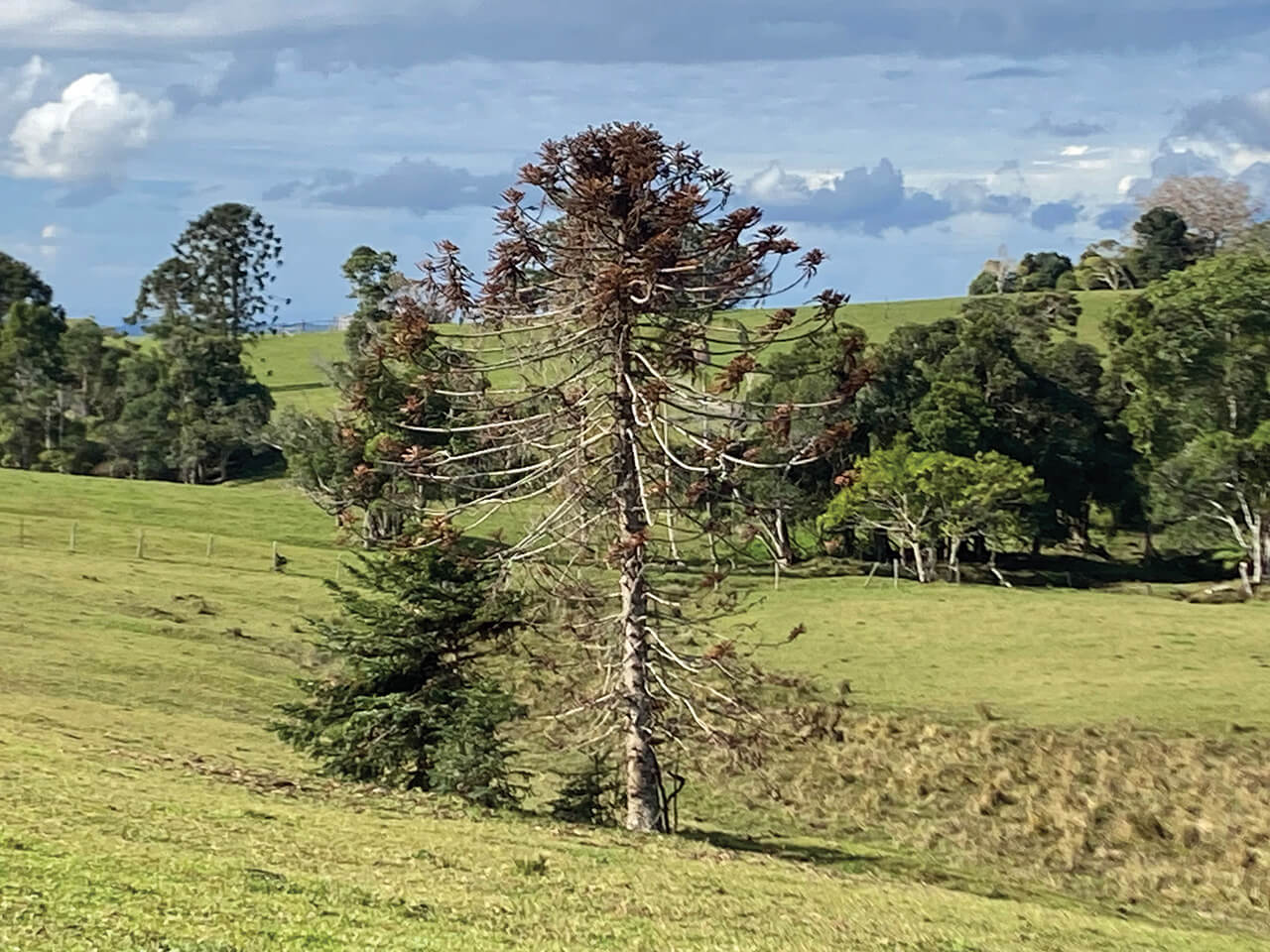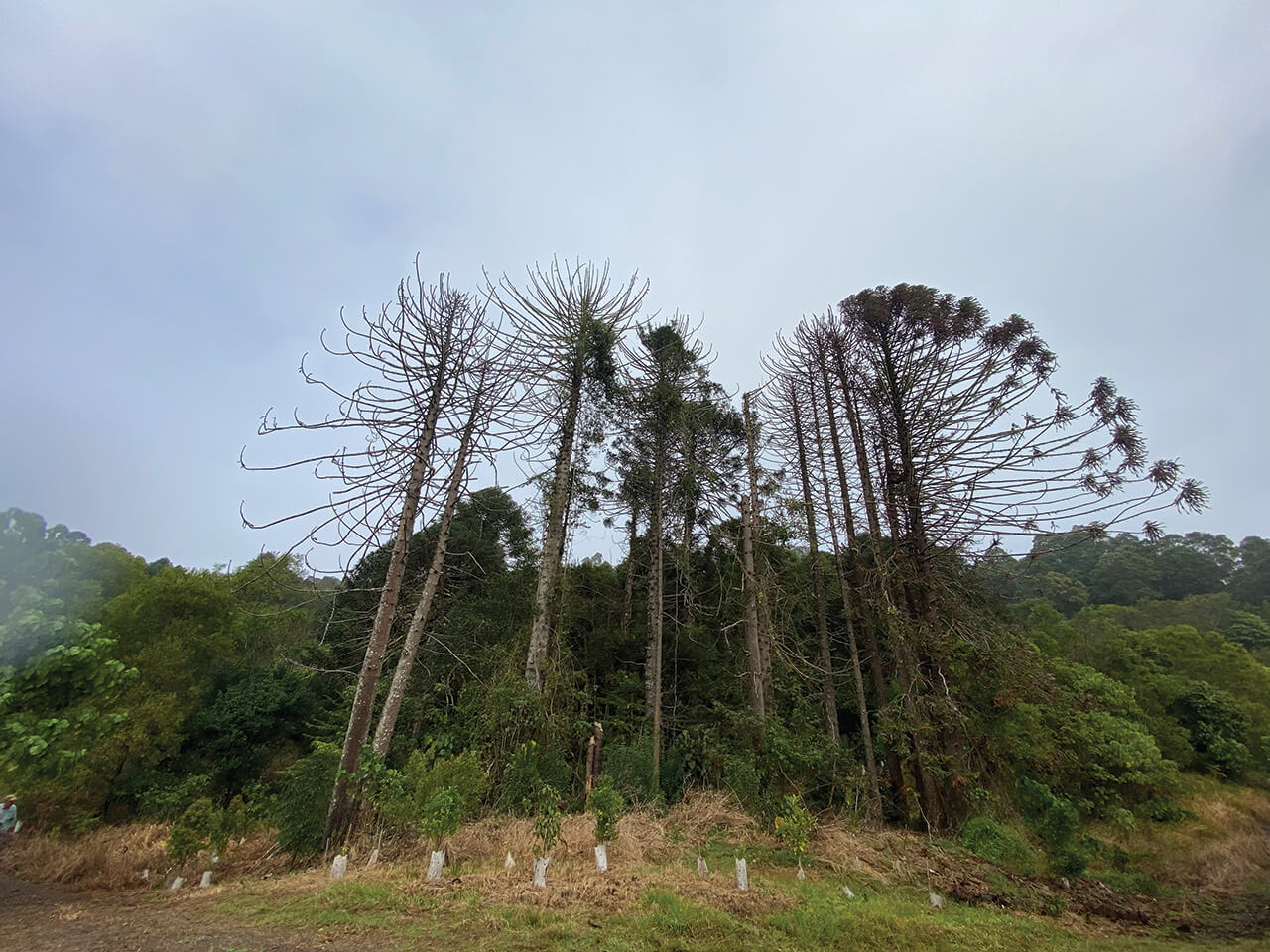The Bunya (Araucaria bidwillii) is one of seven surviving species from the family Araucariaceae in Australia. This family is made up of three genera: 1) Araucaria (e.g. Bunya, Hoop and Norfolk Pines), 2) Agathis (e.g. Kauris) and 3) Wollemia (the Wollemi Pine). These trees have existed as an evolutionary lineage for 150-200 million years. The Bunya Pine is native to Queensland with two tiny populations in north Queensland just inland from Cairns and the larger population in SEQ. The SEQ population extends from Bunya Country on the Blackall and Conondale Ranges and their surrounding catchments in the east and then to the west on the Bunya Mountains – Bonye Biar. These are the only ecosystems on Earth where the Bunya occurs naturally. They are a family of trees that were once widespread across Earth. We are all custodians of the precious remnants that remain.
The Depressingly Dire Disease
Dieback is a global problem and is widespread in Australia. It is a blanket term given to the mass death of trees and other vegetation from climate change, fire management change, ecological disruption and disease pathogens. Susceptible plants can be native e.g. Bunya or exotic e.g. Avocado. The cause of pathogen-based dieback is generally exotic Phytophthora species, such as P. cinnamomi and P. multivora. The condition referred to as ‘dieback’ is generally ascribed to the arrival/importation of an exotic species of Phytophthora infecting and causing damage to plants roots. However, it appears to be more complex than this, in that there are many contributing factors that enable the arrival and establishment of Phytophthora in an area and then also add additional stresses that can lead to the death of trees.
Phytophthora is a genus of oomycetes (water moulds) that are plant pathogens. They live on and in a wide range of plant species and many are relatively host specific (i.e. we only notice them on the plants they’re damaging). Species that you may be familiar with include Phytophthora infestans – Irish Potato Famine, Phytophthora agathidicida – Kauri Dieback, Phytophthora cinnamomi – Dieback affecting many natives and agricultural plants such as Avocado, and last but not least Phytophthora multivora – another dieback species found in association with Eucalypts in WA, Wollemi Pine in the Blue Mountains and Bunya (at the Bunya Mountains).
The word Phytophthora is derived from Greek ‘phyton’ (plant) and the ‘phthora’ (destroyer), so it literally means ‘plant destroyer’. They enter the living tissue of the plants, feed on it and kill infected areas of the plant, generally the roots, and as a result the whole plant weakens and dies.
Research undertaken at the Bunya Mountains National Park suggests that the main species of Phytophthora thought to be responsible for the Bunya dieback is Phytophthora multivora. It appears that Phytophthora multivora was introduced into the area by movement of soil on shoes, or on vehicles or by feral pigs. It’s now over five years since we first saw the presence of Bunya Dieback on the Blackall Range. It’s here and continues to spread.
Multicausal Malady
We know with ourselves, that if we are feeling run down or suffering from a poor diet, that we may be more susceptible and vulnerable to disease. It’s the same with anything in nature, including trees. For example, on the Blackall Range, Bunya that are showing visible symptoms or have succumbed to dieback are limited to trees in rural or rural residential areas. Bunya have evolved as a forest organism, and although through the lens of western society we tend to view all organisms as separate entities, they are of course intrinsically, intertwined with the life they have evolved and co-operate with. In the case of Bunya, that is over 100s of millions of years.
Just like we are learning how important our gut health is to our overall health, soil health is crucial for plants. So, it is with Bunya that are surrounded by lawn or paddock, that they find themselves in a situation that they have not evolved in, their overall health is reduced, and because of this they are more vulnerable to disease. We know that lawns and paddocks reduce top-soil depth and soil biodiversity.
What Can We Do?
- Hygiene. Reduce and prevent pathogen movement to new areas. This can be done by cleaning soil from your boots, tyres of vehicles and bicycles particularly when you’ve accessed an area known to have dieback trees. After cleaning and removing soil the next step you can take is to apply a disinfectant such as methylated spirits and water (70:30) or household bleach (5% active ingredient) and water (20:80). The most crucial step is soil removal, if you skip this step and just apply disinfectants, this will not prevent pathogen movement.
- Access. Even better than good hygiene, the best way to reduce soil-based pathogen movement, is to reduce or eliminate access to areas with dieback or areas that may be vulnerable to infection. In Aotearoa where they are dealing with a similar pathogen causing dieback in Kauri (Agathis australis), Māori communities instigate a temporary, long-term prohibition on access that is referred to as Rahui. This practice allows areas time to rest and prevent further spread. That said, access is often intrinsic to land management. Therefore, take steps to prevent mud from forming on tracks by avoiding access during wet weather or maintaining vegetation cover or using road base.
- Soil Health. Soil health is rarely discussed with regards to dieback management in natural areas, but it is a primary method of control in horticulture and agriculture. Most if not all the hundreds of Bunyas that have died on the Blackall Range over the last five years are located on rural and rural residential properties. Soils in these areas are often low in humus and the soil life that can boost the immunity of trees and keep them healthy and resistant to disease.
Key steps here are again reduced vehicles and livestock access during wet weather to prevent soil compaction. Maintain high levels of organic matter in the soil e.g. leave the ‘annoying prickly’ mulch produced by Bunya under the trees. Mowing under trees removes this mulch and damages roots and increases the risk of infection. In rural residential areas to increase health of your trees you could use composted mulches and chicken manure, this is best practice management in avocado orchards to improve soil health.
Beyond Bunya Dieback
In 2024 Brush Turkey Enterprises in conjunction with Jinibara, Kabi Kabi and Wakka Wakka Peoples, bush regenerators, scientists and rangers, instigated two Beyond Bunya Dieback Symposiums. Drawing inspiration from our partners in Aotearoa (dieback problems are global), who refer to their project as Kauri Ora (Kauri Wellbeing) we decided to give our project a name that focuses not so much on the disease, but on how we look and move beyond this problem. Over 100 people attended the Symposiums with experts and knowledge holders sharing their stories from Australia, Aotearoa and across the world. These Symposiums, community engagement and advocacy to government are all aimed at addressing dieback and promoting healthy country, through sharing of knowledge, research and best practice land management. Only through working together can we all make the necessary changes to protect and regenerate Bunya Country.


*******************************************
In writing this, I acknowledge the Traditional Custodians of Bunya Country, the Elders past present and emerging and their biocultural connection with this country. This relationship has prevailed for tens of thousands of years, through ice ages, sea levels rises and invasion, this connection is eternal, always was and always will be. Bunya is an English language interpretation of Bonyi/Bonyee/Bonye, the name given by the Traditional Custodians of Bunya Country – the Jinibara, Kabi Kabi, Gubbi Gubbi and Wakka Wakka Nations.
*******************************************
Article by Spencer and Karen Shaw
Brush Turkey Enterprises
Land for Wildlife members
Maleny, Sunshine Coast
